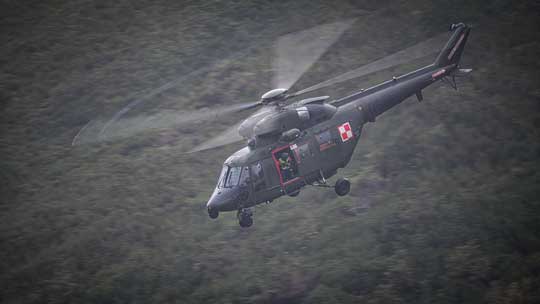
The largest national aviation rescue exercise ended

In one of the scenarios, elements of search and rescue of survivors were practiced in a mountainous area.
from a communications aircraft crash.
On October 6-9, 2020, Poland hosted the largest exercises in the field of air and sea rescue and countering terrorist threats from the air, codenamed RENEGADE/SAREX-20. The main organizer of this project was the Operational Command of the Armed Forces (DO RSZ). General Bronislaw Kwiatkowski.
The main purpose of the exercise was to test the capabilities of the Polish Armed Forces and the non-military system as elements of the state security system to counter the crises inherent in the air defense system, as well as air and sea rescue, including coordination between the central elements. management of the activities of individual services and institutions and local services in the areas of activity.

Air operations with the rescuers of the Karkonosze group of the GOPR included the transportation of rescuers and the removal of the wounded ...
The exercise tested the ability of the Civil-Military Aviation Rescue Coordination Center (ARCC) to launch, direct and coordinate search and rescue operations in the established area of responsibility (FIR Warsaw) and cooperation with relevant services, institutions and organizations, in accordance with the provisions of the ASAR Plan , i.e. Operational plan for search and rescue aviation.
The main projects within the framework of individual episodes were played out in the airspace of the Republic of Poland, Pomeranian Zatoka, Gdansk Zatoka, Karkonosze, in the area of the Parchevsky forestry and in the following voivodeships: West Pomeranian, Pomeranian, Podlasie, Lublin and Lower Silesia.
The exercises involved services, institutions and organizations in Poland responsible for the safety and functioning of the main rescue systems, i.e. units of the Commander-in-Chief of the Armed Forces, the Military Gendarmerie, the Territorial Defense Forces (Territorial Defense Forces) and the non-military system - the Polish Air Navigation Services Agency (PANSA), Police, Border Guard Service, State Fire Service (PSP), Volunteer Fire Brigade (OSP), Maritime Search and Rescue Service (MSPIR), Air Ambulance Rescue Service, Polish Red Cross (PCK), Karkonoska Group of the Voluntary Mountain Rescue Service (GOPR) , a civil airport in Lublin, separate units of the State Medical Rescue System (medical dispatch centers, ambulance units, military and civilian hospitals), as well as the State Security Center with provincial crisis management centers.
Officers in exercises, i.e. the people playing the wounded and the passengers of the hijacked aircraft were cadets from military universities of the Military Aviation Academy, the Military Academy of the Ground Forces, the Military Technology University and students of the Karkonosze State Higher School (KPSV).
During the entire exercise, about 1000 people, 11 aircraft and six military and non-military units were involved in the activities of individual episodes.
The exercise included six episodes, including two episodes related to the functioning of the air defense system of the Republic of Poland, the so-called. part of the RENEGADE exercise and four Airborne Search and Rescue (ASAR) - Search and Rescue (SAR) as part of the SAREX exercise.
Episodes related to countering terrorist threats from the air consisted of two pairs of interceptors flying two civilian aircraft classified as RENEGADE (undetermined or hijacked) to selected intervention airfields. As part of these episodes, the work of ground services was practiced, as well as in the framework of negotiating and rescuing hostages. Within the framework of one episode, civilians were warned about threats from the air.
The next two episodes were related to sea rescue. Two search and rescue operations were carried out, one for the sunken ship, and specialized assistance was provided to people who found themselves under water in the so-called. an air trap, and they were looking for a man who had fallen overboard from a ferry. After the discovery, the evacuation of the wounded to hospitals was carried out by a military aviation search and rescue group from Darlowo and Gdynia. The main subjects of activity were the forces and means of the Navy and the Ministry of Internal Affairs and Administration.
As part of its activities in Karkonosze, the military aviation search and rescue group (LZPR) on a W-3 WA SAR helicopter from the 1st search and rescue group (1st GPR) from Swidwin carried out emergency duty on Mount Shibovtsova. near Jelenia Góra, together with the rescuers of the Karkonosze group, the GOPR carried out a complex search and rescue operation after the crash of a civilian plane with 40 passengers on board. The entire event took place in two locations on the slopes of the Sněžka in Kotla Lomnicki in the Karkonosze National Park and on Volova Mountain in the buffer zone of the park. Rescue work in these areas was supported by a S-70i Black Hawk police helicopter with a Specialized High-Altitude Rescue Team (SGRW) on board, detached from the Rescue and Fire Squad (SPG) No. 7 of the State Fire Service from Warsaw.
The activities, in addition to testing the skills of pilots in flying in mountainous areas, which was one of the main detailed goals of this episode, tested the cooperation of individual services that make up the broadly understood crisis management system. In order to fully utilize the potential of both the military helicopter crews and the rescuers of the Karkonoska GOPR group, and prepare both teams for future tasks, including this year's exercises, from August to September of this year, training was conducted three times for compliance with the elements.
On the day of the episode, in order to create realism for the training groups, 15 students of the Karkonosze State Higher School (KPSh), 25 cadets of the Military Academy of the Army from Wroclaw, policemen and two representatives of the Karkonosze National Park and ARCC, were disguised as the wounded in the morning hours, were transferred to the areas of the future rescue operation.